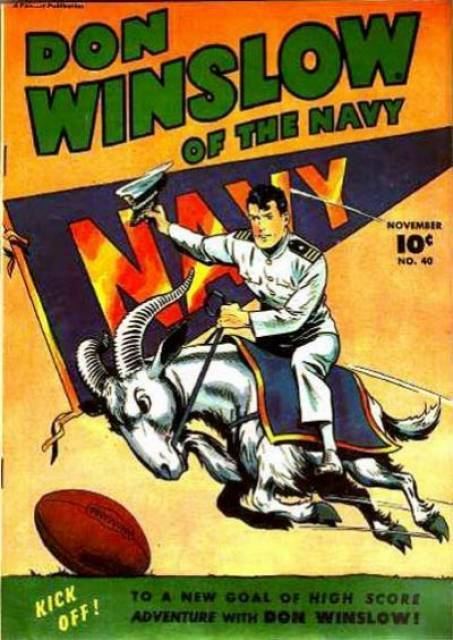 | ||
Similar The Adventures of Smilin, Captain Easy, Tillie the Toiler, The Heart of Juliet Jones, Alley Oop | ||
Don Winslow of the Navy was an American comic strip created by Frank Victor Martinek and distributed by the Bell Syndicate from 1934 to 1955. The title character was a spychasing Lieutenant Commander in Naval intelligence. The comic strip led to a radio adventure serial that began in 1937, as well as film serials that began in 1942. Original comics stories also appeared in Fawcett comic books starting in 1943.
Contents
Publication history
The idea for Don Winslow was conceived by Lieutenant Commander Frank V. Martinek USNR, himself a storied veteran of World War I Naval intelligence, after Admiral Wat T. Cluverius complained to him about the difficulties of recruiting in the Midwest. Ruminating on the challenge, Martinek decided that a comic strip that focused on Naval tradition and courage would educate and fascinate America’s youth. He had previously used the character Don Winslow in some novels he wrote, so he had the main concept readymade. Colonel Frank Knox, later Secretary of the Navy helped sell the idea to the Bell Syndicate.
Martinek brought in Naval Lieutenant Leon Beroth as art director and Carl Hammond to handle layouts and research. Martinek articulated this central principle: "Since Don Winslow of the Navy is approved by the Navy Department, I cannot allow him to do anything that is contrary to the ideals, traditions or motives of the Navy."
The strip debuted on March 5, 1934. A Sunday page was added in 1935. Martinek supervised the daily feature’s "general tone and direction", sending the typewritten continuity to Beroth every week for illustrations. From 1934 to 1952, Beroth was the leading artist on the feature. Ken Ernst (later famous for Mary Worth), assisted or ghosted the art between 1940 and 1942. With Don leaving his fiancee behind in December 1941 to go fight the Japanese, the World War II period saw the height of Don Winslow’s popularity. The strip continued for a full decade after the war ended, coming to a close on Saturday, July 30, 1955.
Although created primarily as a Navy recruitment and propaganda tool, the strip received high marks from Coulton Waugh for “excellent suspense, and ingenious, spine-joggling situations.” Ron Goulart credits Don Winslow with "intrigue, spychasing, beautiful women, and villains with names like Dr. Centaur, the Dwarf, and the Scorpion."
Film serials
Comic book versions
Following up on the success of the comic strip, reprints of the feature in comic book form appeared from various publishers. Merwil, a small publisher, offered reprints in 1937. In 1938 Dell Comics began reprinting the newspaper strips in Crackajack Funnies alongside other established newspaper features. When that title ceased publication in 1942, Don Winslow reprints begin running in Popular Comics, again with other strip favorites of the era. In addition, Dell also had Don Winslow in two issues of their Four Color Comics, a series which spotlighted a different character with nearly every issue. Dell's 1938 one-shot, Famous Feature Stories, contained more Winslow.
Fawcett Publications released the Don Winslow of the Navy comic book with original stories beginning in 1943. The cover of the first issue shows Captain Marvel introducing the character to the readers. This series lasted until 1948, then was revived in 1951, for a total to 69 issues. Winslow was revived again for a final brief time starting in 1955 in reprints published by Charlton Comics.
